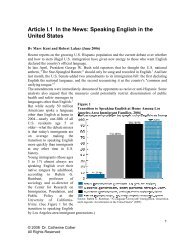A Synthesis of Research on Effective Interventions for Building ...
A Synthesis of Research on Effective Interventions for Building ...
A Synthesis of Research on Effective Interventions for Building ...
Create successful ePaper yourself
Turn your PDF publications into a flip-book with our unique Google optimized e-Paper software.
402JOURNAL OF LEARNING DISABILITIESreading (Chall, 1983). The relati<strong>on</strong>ship<str<strong>on</strong>g>of</str<strong>on</strong>g> fluent oral reading and overall readingability is supported by both empiricaland clinical evidence (Meyer &Felt<strong>on</strong>, 1999; Rasinski, Padak, Linek, &Sturtevant, 1994; Reutzel & Hollingsworth,1993). Despite the importance<str<strong>on</strong>g>of</str<strong>on</strong>g> fluency, its essential role in buildingoverall reading ability has <strong>on</strong>ly recentlybeen highlighted (NRP, 2000).Fluency appears to be particularlyimportant <strong>for</strong> students with significantreading problems, because they <str<strong>on</strong>g>of</str<strong>on</strong>g>tenhave labored reading with manypauses, which results in slow and disc<strong>on</strong>nectedoral reading. This ef<strong>for</strong>tfulreading is problematic because it focusesreading at the decoding andword level, which makes comprehensi<strong>on</strong>virtually impossible. Chall (1979)described these readers as “glued toprint” (p. 41) and unable to delight inthe reading <str<strong>on</strong>g>of</str<strong>on</strong>g> text. The students withLD who were the target group <strong>for</strong> thissynthesis represent a large subgroup <str<strong>on</strong>g>of</str<strong>on</strong>g>dysfluent readers.The Nati<strong>on</strong>al Reading Panel (2000)summarized findings about guided repeatedoral reading as a means to improvefluency and indicated that theoverall weighted effect size produced amoderate effect <strong>for</strong> repeated oral reading.The NRP presented the case thatinstructi<strong>on</strong> in guided oral reading is animportant part <str<strong>on</strong>g>of</str<strong>on</strong>g> a reading programand is associated with gains in fluencyand comprehensi<strong>on</strong>. Oral reading interventi<strong>on</strong>swere found to be superiorto instructi<strong>on</strong> encouraging students toread silently. Furthermore, the NRPreported that good and poor readersboth benefited from the repeatedguided reading, although they maybenefit differentially from different aspects<str<strong>on</strong>g>of</str<strong>on</strong>g> the treatment (Faulkner &Levy, 1999). However, the NRP readingfluency synthesis did not address theextent to which individuals with LDmight benefit from fluency interventi<strong>on</strong>sor the extent to which other types<str<strong>on</strong>g>of</str<strong>on</strong>g> fluency interventi<strong>on</strong>s (other thanoral repeated reading) might be associatedwith improvements in fluencyand other aspects <str<strong>on</strong>g>of</str<strong>on</strong>g> reading.The purpose <str<strong>on</strong>g>of</str<strong>on</strong>g> this study was toprovide a synthesis <str<strong>on</strong>g>of</str<strong>on</strong>g> the research <strong>on</strong>fluency interventi<strong>on</strong>s c<strong>on</strong>ducted withstudents with LD. Our goal was to locateall interventi<strong>on</strong> studies publishedand all dissertati<strong>on</strong>s c<strong>on</strong>ducted withinthe past 25 years that evaluated the effects<str<strong>on</strong>g>of</str<strong>on</strong>g> fluency training <strong>on</strong> elementarystudents with LD. The comprehensivesearch yielded 24 studies: 8 multiplegroup, 5 single group, and 11 casestudies or single-subject design studies.Two <str<strong>on</strong>g>of</str<strong>on</strong>g> the single-group studieswere part <str<strong>on</strong>g>of</str<strong>on</strong>g> factorial designs that alsoincluded other samples.Be<strong>for</strong>e interpreting the findings <str<strong>on</strong>g>of</str<strong>on</strong>g>the present synthesis, it is important t<strong>on</strong>ote that effect sizes can be c<strong>on</strong>sidered<strong>on</strong>ly within the c<strong>on</strong>text <str<strong>on</strong>g>of</str<strong>on</strong>g> the comparis<strong>on</strong>swith which treatment groupswere c<strong>on</strong>trasted. Because effect sizesare largely dependent <strong>on</strong> the nature <str<strong>on</strong>g>of</str<strong>on</strong>g>the comparis<strong>on</strong> groups, it is criticalthat a synthesis include detailed in<strong>for</strong>mati<strong>on</strong>regarding the comparis<strong>on</strong>s. Forthis reas<strong>on</strong>, Tables 1 through 5 includedetails <str<strong>on</strong>g>of</str<strong>on</strong>g> both treatment and comparis<strong>on</strong>c<strong>on</strong>diti<strong>on</strong>s. However, comparis<strong>on</strong>groups differ c<strong>on</strong>siderably across samples,complicating the interpretati<strong>on</strong> <str<strong>on</strong>g>of</str<strong>on</strong>g>the findings. The interpretati<strong>on</strong>s thatfollow were developed with this limitati<strong>on</strong>in mind.In general, the findings from thissynthesis suggested that repeatedreading interventi<strong>on</strong>s <strong>for</strong> studentswith LD are associated with improvementsin reading rate, accuracy, andcomprehensi<strong>on</strong>. This would providesupport <strong>for</strong> the theory <str<strong>on</strong>g>of</str<strong>on</strong>g> automaticityproposed by LaBerge and Samuels(1974) and extended as a verbal efficiencymodel by Perfetti (1977, 1985).These studies, and the theory supportingthem, provide evidence that thefocus <strong>on</strong> developing students’ rapidprocessing <str<strong>on</strong>g>of</str<strong>on</strong>g> print by reading targetpassages more than <strong>on</strong>ce is <str<strong>on</strong>g>of</str<strong>on</strong>g>ten effectiveas a means to improve accuracyand speed, and ultimately leads to betterunderstanding <str<strong>on</strong>g>of</str<strong>on</strong>g> text.One procedure <strong>for</strong> enhancing fluencyis <strong>for</strong> teachers to model reading<str<strong>on</strong>g>of</str<strong>on</strong>g> text by reading aloud to students(Dowhower, 1987; H<str<strong>on</strong>g>of</str<strong>on</strong>g>fman, 1987;Smith, 1979). Repeated reading with amodel seems to be more effective thanrepeated reading with no model, particularly<strong>for</strong> students with low fluency(e.g., Rose & Beattie, 1986; Smith, 1979).Tape- or computer-modeled readingseems more effective than having nomodel but may not be as effective asteacher modeling (Daly & Martens,1994; Rose & Beattie, 1986). Furthermore,having text read initially by amodel promoted comprehensi<strong>on</strong>, perhapsbecause it allowed students t<str<strong>on</strong>g>of</str<strong>on</strong>g>ocus initially <strong>on</strong> the c<strong>on</strong>tent <str<strong>on</strong>g>of</str<strong>on</strong>g> the passagebe<strong>for</strong>e they read it themselves(M<strong>on</strong>da, 1989; Rose & Beattie, 1986).Asking peers, who are <str<strong>on</strong>g>of</str<strong>on</strong>g>ten betterreaders, to serve as the model <strong>for</strong> studentswith LD was investigated in severalstudies reported here and reviewedin separate syntheses (Elbaum,Vaughn, Hughes, & Moody, 1999;Mathes & Fuchs, 1994). Repeated readingwith a partner as a means to improvingfluency has yielded somewhatequivocal results (e.g., Marst<strong>on</strong>, Deno,D<strong>on</strong>gil, Diment, & Rogers, 1995), althoughthere are few studies documentingits effectiveness al<strong>on</strong>e (Marst<strong>on</strong>et al., 1995; Mathes & Fuchs, 1994).In a separate analysis <str<strong>on</strong>g>of</str<strong>on</strong>g> the effects <str<strong>on</strong>g>of</str<strong>on</strong>g>peer tutoring <strong>on</strong> broad reading outcomes,cross-age tutoring was associatedwith higher mean weighted effectsizes (.50) than cooperative partners(.00), and with peer tutoring, the role <str<strong>on</strong>g>of</str<strong>on</strong>g>the student within the pair had a significanteffect <strong>on</strong> outcomes, with reciprocaltutor–tutee roles dem<strong>on</strong>stratinglow mean weighted effect sizes (.09; Elbaum,Vaughn, Hughes, & Moody,2000).Speed and accuracy have traditi<strong>on</strong>allybeen c<strong>on</strong>sidered the hallmarks ormost essential features <str<strong>on</strong>g>of</str<strong>on</strong>g> fluency(LaBerge & Samuels, 1974; Samuels,1997). Most researchers agree that accuracyin itself is insufficient and thatstudents need to read rapidly if theyare going to understand the c<strong>on</strong>necti<strong>on</strong>sthat need to be made betweenideas in print (Nathan & Stanovich,1991). Variables associated with effects
















